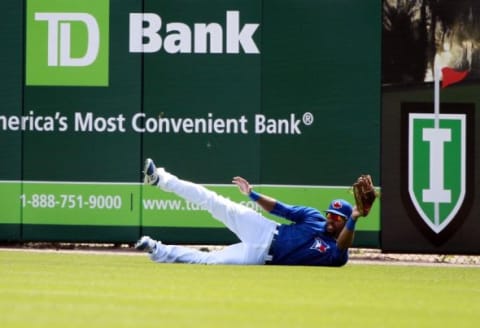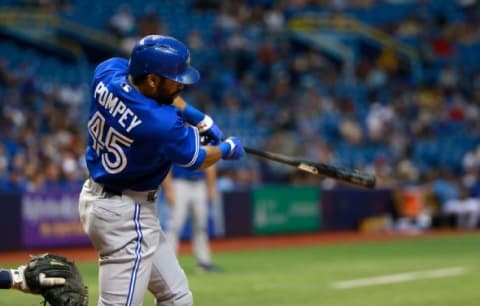Blue Jays left-field battle: 3 Preliminary Dalton Pompey factors


With the Blue Jays starting left-field job open for competition, we look at the direct (and indirect) factors facing the young Canadian Dalton Pompey
This wasn’t where Dalton Pompey envisioned himself being one year ago.
The Blue Jays centre-fielder of the future seemed poised for an early arrival at just 22-years-old. A 2014 minor league campaign split between Dunedin, New Hampshire and Buffalo had skyrocketed him towards “next big thing” status, but as is often the case, his debut performance with the big club did not go as planned.
More from Jays Journal
- Matt Chapman has been exactly what the Blue Jays needed
- Blue Jays: The goalposts are moving in the right direction
- Single-A Dunedin Blue Jays advance to the Championship Series
- Blue Jays: Comparisons for Alek Manoah’s Second Season
- Blue Jays: Adam Cimber, the unlikely decision King
Now, Pompey enters Toronto’s 2016 spring training vying for a job in left-field, the presence of Kevin Pillar in centre eliminating any potential of a return to his natural position in the near future at the major league level.
Yesterday, I wrote that Shi Davidi of Sportsnet had suggested the starting job was Michael Saunders’ to lose. An idea that, agree with it or not, has legs from the organization’s standpoint.
The direct one-on-one competition between Pompey and Saunders will play the majority factor here, of course, but when looking at this situation from Pompey’s corner, a handful of external elements could enter the picture as well.
1) The competition within the competition
Pompey is not just competing against the man next to him in Saunders, he’s also competing with a handful of players who currently sit behind him on the depth chart.
Ezequiel Carrera found his way into more 2015 games than ever expected and seemed to earn the trust of manager John Gibbons. Junior Lake still possesses some high-ceiling (albeit wildly unpredictable) potential and is out of minor league options, while recent trade addition Darrell Ceciliani is coming off a breakout season at the triple-A level and has the physical tools to work with.
I would argue that a strong at-bat or defensive play from one of those three names this spring is something that will work in Saunders’ favour. Any temptation to return Pompey to triple-A Buffalo for additional seasoning will be made much easier if a true and impactful fourth outfielder emerges.
Next: Factor 2: Are we forgetting about the glove?

2) The value of defence
On a surface level, the competition between Pompey and Saunders has often been laid out with simpler counting stats. Batting average, on-base percentage (especially given the vacant leadoff spot), stolen bases, the list goes on. But why has there been so little love for the glove?
The Chris Colabello and Danny Valencia experiments of 2015 have set the bar in left rather low defensively, and especially in such a strong offensive lineup, Pompey could benefit by being a superior defender to his competitors.
Perhaps more importantly, he’s a natural centre-fielder with the ability to spell off Pillar if and when that is needed.
Pillar appeared in a whopping 159 games last season, but if injury or a day of rest are required, Pompey manning centre is more attractive than the alternatives. How much will that matter to Gibbons and the Jays management?
Granted, Saunders has played over 2000 major league innings in centre-field, but to a UZR/150 of -6.0. In over 1300 innings spent in left, that UZR/150 is a more comfortable 0.9.
Pompey has yet to rack up enough major league innings to produce any meaningful defensive metrics (which are a tricky tool to begin with), but his defence has the potential to be Gold Glove calibre down the road. In fact, as a young prospect with the 2013 Lansing Lugnuts, Pompey earned the Rawlings Gold Glove Award for the best defensive centre-fielder in all of minor league baseball.
Next: Factor 3: Fitting into the larger organizational strategy

3) The new regime’s development strategy
This is a bigger-picture item that we may not have a true handle on until 12 months from now, but the Pompey decision will be a start.
With Shapiro and Atkins now steering the ship, one which includes a farm system thinned by the 2015 trade deadline, how aggressive will the organization be in “advancing” Pompey or younger prospects through the ascending levels.
For example, towards the end of the Alex Anthopoulos era, the club became very aggressive in promoting their high-upside young arms. That strategy landed Miguel Castro and Roberto Osuna on last season’s opening day roster.
Over the past two months, both Shapiro and Atkins have circled back several times to highlight the fact that they need to get a handle on the players within the organization, most recently in regards to the Jose Bautista and Edwin Encarnacion contract situations. Get to know them, both on and off the field.
Next: The 5 greatest Blue Jays to never reach the playoffs
Simply put, they will value Pompey in the future and present differently than Alex Anthopoulos did. Perhaps they are more wary of his potential ceiling, or perhaps, despite believing he has All-Star abilities down the road, they still want to see him perform at the triple-A level in front of their own eyes before pulling the trigger.
Furthermore, how will the current organizational makeup really impact this decision, if at all? Will the weakened farm produce a more cautious approach, not wanting to misstep with one of the club’s brightest young talents? Or will the urgency to win in 2016 put that out the window, resulting in the “best 25” heading north?
While Saunders’ situation isn’t completely black and white, especially given his 2015 knee injury, his case for the starting left-field job does seem to include fewer factors that are out of his control.
Soon enough, we begin to see if the factors above work for, or against, Dalton Pompey.